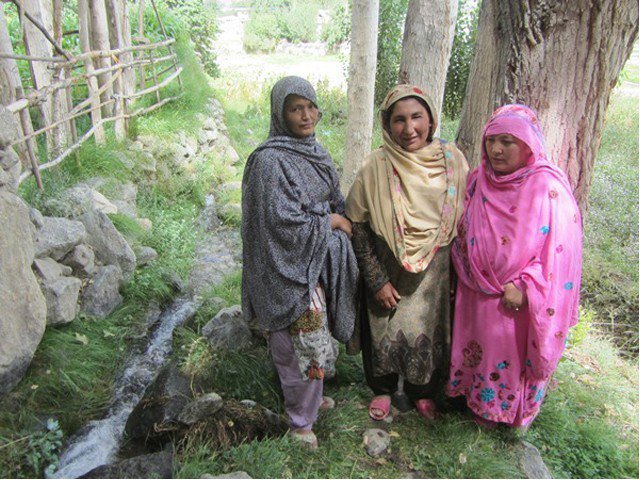Siksa Valley: Turning Gilgit-Baltistan’s barren lands into green miracles
Sep 17 2018 | 04:12:01
I had never been past Khaplu in the Ganche District of Baltistan, a lovely green valley encircled by towering mountains. I had stayed a few times at the picturesque Khaplu Fort Palace Hotel, which has painstakingly been restored by the Aga Khan Trust for Culture.
Hence, I was excited to actually drive past Khaplu and head further north towards our border area with India’s Ladakh region. This is a restricted area controlled by the Army and most tourists are turned back. Luckily, we had clearances as we were heading to a village called Siksa, around an hour and a half drive from Khaplu, where Aisha Khan, the intrepid CEO of the Mountain and Glacier Protection Organisation (MGPO) was implementing a water replenishment project with the support of United Nations Development Programme-Pakistan (UNDP) and the Coca Cola Foundation.During our journey, we stopped at perhaps what is one of the most stunning views in Pakistan – the lookout point for Masherbrum or K1 Mountain. Almost 8,000 metres high, its summit was lost in the clouds but the vast, flat valley before us and the snowy peaks beyond were an incredible sight.After taking in the breathtaking view, we reluctantly got back in our jeeps and headed to the fertile Siksa Valley, whose residents proudly claim that after Hunza Valley, they are the most progressive and well-educated of the high mountain communities of the Gilgit-Baltistanregion. Certainly, Siksa is a lovely valley, with its terraced fields and neat houses adorned with flowerpots.
Welcome to PakistanSiksa Valley: Turning Gilgit-Baltistan’s barren lands into green miraclesBy Rina Saeed Khan an hour ago3SHARES SHARE TWEET EMAIL(R to L): Sakina, Khanum and their friend pose for a photo next to a water channel in Siksa Valley, Gilgit-Baltistan. PHOTO: RINA SAEED KHANI had never been past Khaplu in the Ganche District of Baltistan, a lovely green valley encircled by towering mountains. I had stayed a few times at the picturesque Khaplu Fort Palace Hotel, which has painstakingly been restored by the Aga Khan Trust for Culture.The Khaplu Fort Palace HotelHence, I was excited to actually drive past Khaplu and head further north towards our border area with India’s Ladakh region. This is a restricted area controlled by the Army and most tourists are turned back. Luckily, we had clearances as we were heading to a village called Siksa, around an hour and a half drive from Khaplu, where Aisha Khan, the intrepid CEO of the Mountain and Glacier Protection Organisation (MGPO) was implementing a water replenishment project with the support of United Nations Development Programme-Pakistan (UNDP) and the Coca Cola Foundation.During our journey, we stopped at perhaps what is one of the most stunning views in Pakistan – the lookout point for Masherbrum or K1 Mountain. Almost 8,000 metres high, its summit was lost in the clouds but the vast, flat valley before us and the snowy peaks beyond were an incredible sight.After taking in the breathtaking view, we reluctantly got back in our jeeps and headed to the fertile Siksa Valley, whose residents proudly claim that after Hunza Valley, they are the most progressive and well-educated of the high mountain communities of the Gilgit-Baltistanregion. Certainly, Siksa is a lovely valley, with its terraced fields and neat houses adorned with flowerpots.View point of Masherbrum peak in Ganche district, Karakoram.In Siksa, I got a tour of the village and was accompanied by the shy Khanum, a villager who lives above Siksa, and Sakina, a confident mother of three children. They told me:“Thanks to the new water storage tank, all these fields have turned green.”They proceeded to inform me a little bit about their village and themselves. As is the norm in many mountain villages here, both Khanum and Sakina tend the fields and look after their households on their own as their husbands work in Skardu, which is almost a four-hour drive from there. Khanum pointed out the terraced fields below the towering mountains, watered by the channels, where vegetables like organic tomatoes, onions, aubergines, okra and pumpkins were growing. No pesticides or fertilisers are used in these high mountains, as the soil is full of minerals. Khanum plucked out some freshly grown ripe tomatoes to show us and they looked delicious. They both enlightened me,“The soil of Siksa is very fertile; all we needed was enough water for irrigation. We are so grateful to the NGO for helping us.Interestingly, the community contributed around one-fifth to the project cost and the labour.The water storage tank was built a year ago, and is supplied by a pipeline that transports water from a natural spring high up in the mountains above Siksa, situated at an elevation of around 11,000 feet. The pipeline is buried in the soil so it does not freeze in the winter. It is a simple technology based on the steep gradient of the mountain slopes, but it has proved to be a near miracle for the 500 households of Siksa village. The storage tank high above the village supplies water to various irrigation channels flowing down to the settlements below.I climbed up to take a look at one of them and indeed the water was gushing down the slopes. Today, around 4,000 community members are benefiting from this scheme. The storage tank has a capacity of 8,000 gallons (from both spring water and snow melt). It was inaugurated in the spring of 2017 and that summer, they had their first big crop of vegetables. This year, another bumper crop has arrived of tomatoes, onions and potatoes, which they can sell to the nearby markets.For More detail:https://blogs.tribune.com.pk/story/71762/siksa-valley-turning-gilgit-baltistans-barren-lands-into-green-miracles/
